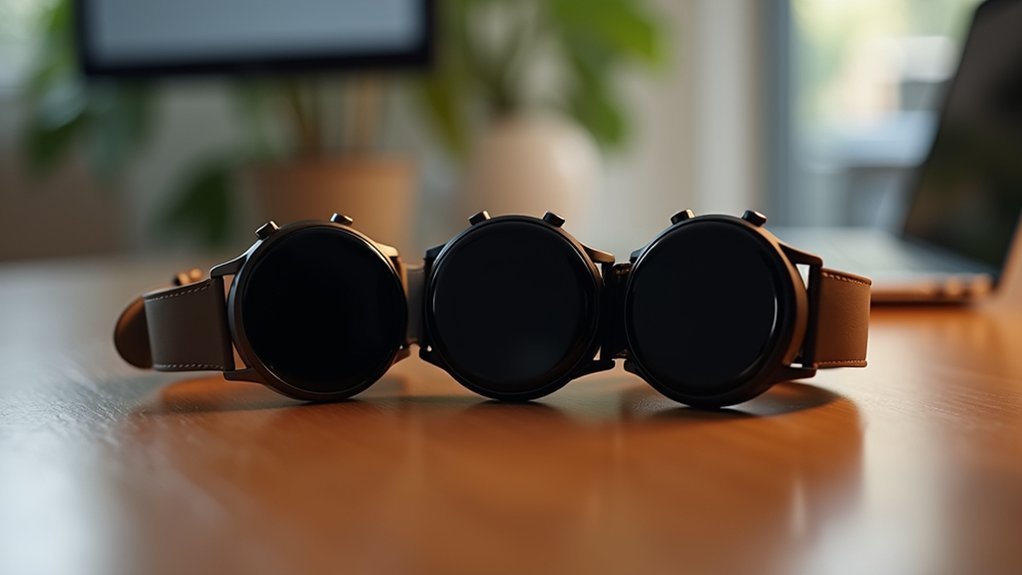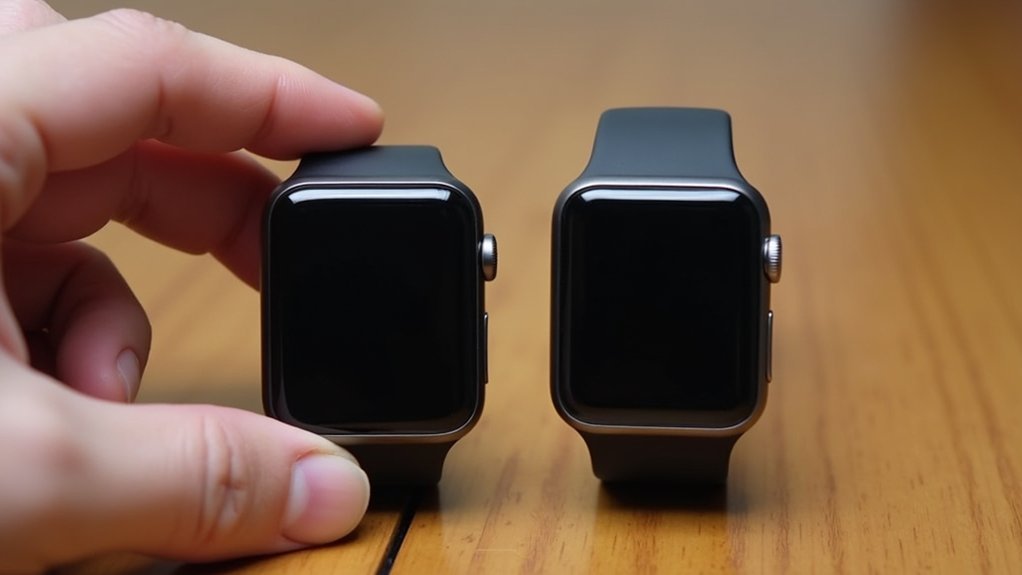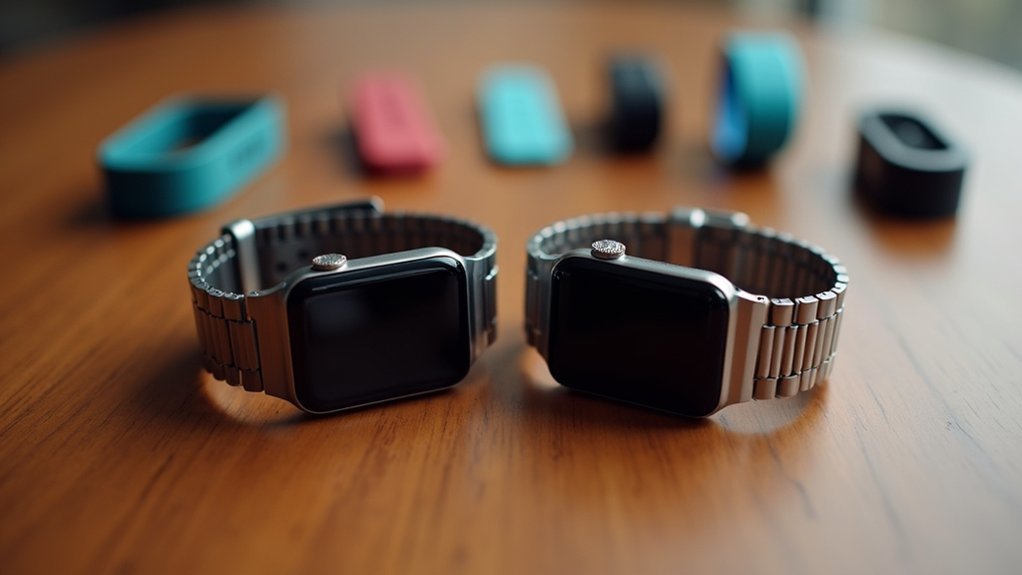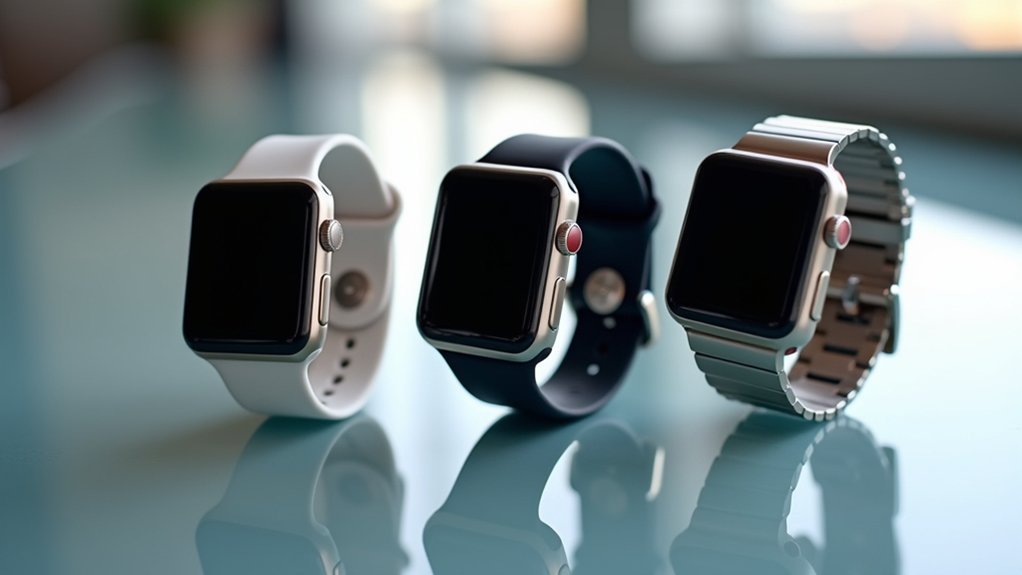Your smartwatch’s operating system shapes every interaction you’ll have with your device. watchOS offers seamless Apple ecosystem integration with advanced health monitoring and granular notification controls, while Wear OS provides broader compatibility across Android and some iOS devices with extensive Google service integration. Samsung’s One UI delivers context-based filtering and body composition analysis, whereas Garmin excels in outdoor activities with superior battery life. Each platform’s unique strengths will determine which best matches your specific needs and preferences.
Notification Management Across Different Smartwatch Platforms

When you’re managing notifications on your smartwatch, the operating system fundamentally shapes how you’ll interact with alerts throughout your day.
Different platforms offer distinct approaches to notification handling and display.
watchOS provides seamless integration with Apple devices, offering customizable responses and detailed alert settings with specific sounds or vibrations.
You’ll find exclusive features like Scribble for quick responses directly from your watch.
Wear OS uses a card-based notification stack, making it easy to scroll through multiple alerts while offering quick actions for replying to messages.
Voice commands enhance hands-free interaction within Google’s ecosystem.
Samsung’s One UI features notification prioritization, letting you control which apps display alerts, while Tizen supports third-party apps for enhanced capabilities.
These notification systems determine how you’ll maintain user connectivity and manage your daily digital interactions effectively.
Pebble OS offers cross-platform compatibility with minimalistic, clutter-free notification displays.
Real-Time Alert Customization and App-Specific Settings
You’ll find that modern smartwatch platforms offer sophisticated instant notification filtering that lets you control which alerts reach your wrist in real-time.
These systems allow you to set granular app-specific controls, determining not just which apps can send notifications, but when and how they’re delivered based on your current activity or time of day.
Whether you’re using watchOS’s priority sorting or Wear OS’s context-aware filtering, you can fine-tune each app’s behavior to match your daily routine and preferences. Tizen’s HTML5 development framework enables developers to create custom notification experiences that can operate independently without requiring constant smartphone connectivity.
Instant Notification Filtering Options
How effectively can your smartwatch filter the constant stream of notifications without missing what truly matters? Your filtering options depend heavily on which operating system you’re using.
WatchOS provides the most seamless experience, syncing app-specific controls instantly with your iPhone settings. You’ll get deep customization that feels natural within Apple’s ecosystem.
Wear OS focuses on Google service integration, offering quick filter adjustments and smart notification stacking that learns your preferences.
Samsung’s One UI delivers context-based filtering for driving, sleeping, or meetings, though cross-device syncing sometimes lags behind competitors. The diverse options available mean consumers have varying experiences depending on their chosen Android wearable brand.
All major platforms now support temporary focus modes that suppress non-essential alerts, while custom vibration patterns and immediate management options help you stay informed without constant interruption.
App-Specific Alert Controls
Beyond broad notification filtering, each smartwatch platform handles individual app controls differently, giving you varying degrees of precision over what reaches your wrist.
WatchOS leads in customization, letting you adjust specific app alerts directly from your watch in real-time. You’ll find seamless integration with iOS apps and intuitive settings management.
Wear OS offers standalone app installation with independent notification controls, working across both Android and iOS devices. With over 40 million Wear OS smartwatches in use, the platform provides robust third-party app support for enhanced notification management.
Samsung’s One UI provides extensive app prioritization features, including quiet hours and specific app silencing options for Samsung device users.
Pebble OS supports basic app-specific settings through its store, while Garmin Connect IQ focuses primarily on sports applications rather than general notification management, offering specialized customization for fitness enthusiasts.
Interactive Notification Features and Quick Response Options

You’ll find that modern smartwatch operating systems excel at transforming passive notifications into interactive experiences through real-time alert customization that adapts to your preferences and usage patterns.
Direct reply capabilities let you respond to messages, emails, and social media notifications right from your wrist using voice dictation, pre-written responses, or on-screen keyboards.
Actionable watch notifications go beyond simple alerts by enabling you to accept calendar invites, control smart home devices, or dismiss reminders without ever touching your phone. However, these interactive features may contribute to the daily battery drain that most smartwatches experience during regular usage.
Real-Time Alert Customization
When notifications arrive on your smartwatch, your ability to customize and interact with them can dramatically impact your daily workflow and productivity.
Different operating systems offer varying levels of real-time alert customization to help you manage interruptions effectively.
WatchOS provides the most granular control, allowing you to customize notifications per app and alert type. You’ll find extensive scheduling options like Do Not Disturb and Sleep modes, plus app priority controls that sync seamlessly with your iPhone.
Wear OS syncs Android’s Priority Mode to your watch, offering customizable notification categories and priority tagging. Samsung’s One UI goes further, enabling notification priority settings and automatic silencing during preset hours.
However, Fitbit OS and Garmin OS focus on essential alerts with limited customization options, while Moto Watch OS provides basic time and activity notifications without third-party app control. Modern smartwatches also integrate voice assistants to provide hands-free interaction with notifications and quick response capabilities.
Direct Reply Capabilities
Managing incoming alerts effectively requires more than just customization—you need the ability to respond quickly without reaching for your phone.
Wear OS excels here with Google Assistant integration, letting you reply to messages and adjust calendar events through voice commands or quick actions. You’ll find cross-platform compatibility works seamlessly with both Android and iOS devices.
WatchOS delivers highly customizable notifications with direct response options, allowing you to set predefined messages or type responses directly from your wrist.
Siri enables voice-activated replies for hands-free convenience.
Tizen falls behind with less robust direct reply capabilities, though it offers quick access to frequently used apps. Samsung’s operating system provides Urdu language support, making it more accessible for users who prefer responding to messages in their native language.
While you can prioritize certain notifications, the response features aren’t as polished as its competitors.
Actionable Watch Notifications
Interactive notifications transform your smartwatch from a passive display into a control center for your digital life.
You’ll find varying levels of sophistication across operating systems, with each offering unique approaches to managing alerts and responses.
Modern smartwatches provide three key actionable notification features:
- Voice Integration – Wear OS leverages Google Assistant for voice-responsive actions, while watchOS incorporates Siri for hands-free notification management.
- Gesture Controls – Swipe gestures let you dismiss, view, or interact with notifications across all major platforms without complex navigation.
- Quick Actions – Direct responses like calendar management, message replies, and app-specific controls appear within notification cards.
Your notification experience depends heavily on your chosen ecosystem. Product registration can provide access to enhanced support resources when troubleshooting notification-related issues.
Samsung’s One UI offers priority filtering and quiet hours, while watchOS provides extensive customization options for different apps and alert types.
Comprehensive Health Monitoring and Sensor Integration

Although all major smartwatch operating systems now include basic heart rate monitoring as standard, the depth and accuracy of health sensor integration varies considerably across platforms.
You’ll find advanced features like ECG and blood oxygen tracking on flagship models from Apple, Samsung, and Fitbit, with Apple Watch and Fitbit Sense offering FDA-cleared ECG capabilities.
Samsung’s Galaxy Watch 4+ stands out with body composition analysis, while Garmin excels in heart rate variability monitoring for recovery insights.
Your choice depends on ecosystem compatibility and monitoring priorities.
Apple Watch integrates seamlessly with iPhone users but lacks cross-platform flexibility.
Wear OS offers broader compatibility, while Garmin provides exceptional battery life for continuous monitoring. Modern smartwatches also enable contactless payments for added convenience during workouts and daily activities.
Fitness Tracking Capabilities and Third-Party App Support
Beyond basic health monitoring, fitness tracking capabilities reveal significant differences between smartwatch operating systems, particularly in workout variety and third-party app integration.
You’ll find watchOS delivers extensive tracking with advanced metrics like heart rate variability, supported by Apple’s extensive app ecosystem including Strava and Spotify.
Wear OS provides flexible tracking through Google Play Store access, though some apps aren’t fully optimized for smartwatch interfaces.
Samsung’s One UI excels with built-in guided workouts and sleep tracking, while Garmin OS specializes in outdoor activities with robust GPS and offline maps. Garmin devices feature exceptional battery life optimization, ensuring extended usage during lengthy outdoor adventures without functionality loss.
Consider these key factors when choosing:
- App diversity – Wear OS and watchOS offer the broadest selection
- Native integration – Samsung and Fitbit provide seamless built-in experiences
- Specialization focus – Garmin targets serious athletes and outdoor enthusiasts
Advanced Health Metrics and Performance Analytics
How accurately can your smartwatch detect serious health conditions before symptoms appear? Advanced health monitoring varies markedly across operating systems.
WatchOS leads with ECG functionality and irregular heartbeat alerts that can detect arrhythmias before you notice symptoms. You’ll get blood pressure monitoring with 84.6% sensitivity and 88.9% specificity at clinical thresholds, making hypertension detection reliable.
Your SpO2 sensors track blood oxygen levels between 95-100%, while respiratory rate monitoring counts 12-20 breaths per minute for healthy adults.
WatchOS excels at heart rate variability tracking for stress assessment, while Samsung’s One UI provides thorough sleep analytics combining REM, deep, and light phases. These devices can seamlessly share health data with healthcare providers to support preventive care initiatives.
For athletes, watchOS delivers VO2 max estimation and running power metrics, while Wear OS offers customizable third-party integrations through Strava and Google Fit for enhanced performance granularity.
App Store Ecosystems and Developer Platform Support
Your smartwatch’s health monitoring capabilities depend heavily on the apps you can actually download and use. The platform you choose greatly affects your access to popular fitness and productivity applications.
Here’s what you’ll find across major platforms:
- WearOS offers the most extensive app library through Google Play Store, featuring popular options like Spotify and Strava, plus familiar Android Studio development tools.
- watchOS provides highly curated, exclusive apps through strict App Store review processes, though developers need Xcode and iOS familiarity. Future growth anticipates AI-powered health insights becoming available by 2025.
- HarmonyOS struggles with limited global app availability outside China, relying on Huawei’s proprietary development tools that most developers don’t know.
Cross-platform apps like Google Fit guarantee some consistency, but ecosystem integration varies greatly between platforms.
Software Update Distribution and Platform Exclusivity
While app availability sets the foundation for your smartwatch experience, the frequency and timing of software updates determine whether you’ll actually receive new features and security patches.
Apple Watch leads with multiple incremental updates yearly and near-universal adoption rates, thanks to mandatory installation prompts. Google’s Pixel Watch follows closely with guaranteed monthly security patches and immediate firmware availability.
Samsung Galaxy Watch users get regular updates, though timing varies by region and carrier customization. Other Wear OS brands lag considerably in both frequency and consistency. Samsung’s Galaxy Watch Ultra operates on Wear OS 5.0 with One UI Watch 6.0, demonstrating the current state of Samsung’s software integration.
Platform exclusivity creates additional barriers. Apple Watch features require an iPhone, while Samsung’s best integrations need Galaxy phones.
This lock-in effect means you’re not just choosing a watch—you’re committing to an entire ecosystem that dictates your update experience.
Battery Performance Optimization Across Operating Systems
Your smartwatch’s battery life depends heavily on which operating system it runs and how well that OS manages your daily usage patterns.
Different platforms handle power management features with varying levels of efficiency – while Garmin OS can stretch battery life for days even with heavy GPS use, Wear OS typically maxes out at four days under normal conditions.
You’ll find that understanding these efficiency differences across platforms helps you choose a smartwatch that matches your charging preferences and usage demands. Premium models often incorporate advanced efficiency technologies that optimize both hardware and software integration for superior battery performance.
Daily Usage Patterns
Battery life becomes the ultimate determining factor when you’re choosing between smartwatch operating systems for daily use.
Your daily habits directly impact how long your watch lasts between charges, and different operating systems handle these demands differently.
Consider these key usage patterns that affect battery performance:
- Screen interaction frequency – Constant notifications and display activation drain Wear OS watches faster than Garmin’s efficient platform.
- Activity tracking intensity – Continuous heart rate monitoring and GPS usage reduce battery life across all systems, though Garmin maintains superiority.
- App dependency levels – Heavy app usage greatly impacts Wear OS and Samsung watches, while Fitbit OS remains more conservative.
The OnePlus Watch 2 demonstrates exceptional efficiency with its Wear OS Hybrid Interface that utilizes a low-powered coprocessor for background tasks.
You’ll find that matching your usage style with the right operating system maximizes daily performance and minimizes charging interruptions.
Power Management Features
Each smartwatch operating system employs distinct power management strategies that directly influence how efficiently your device conserves energy throughout the day.
WearOS relies on app optimizations and sleep modes, though battery life varies considerably due to hardware fragmentation across manufacturers. You’ll find some models lasting up to two days with recent multitasking improvements.
watchOS leverages proprietary S-series chips for superior efficiency, while seamless Apple ecosystem integration minimizes unnecessary data transfers. Low power modes extend usage when you’re not actively wearing your device.
HarmonyOS excels in efficiency on Kirin-powered Huawei devices, utilizing specialized hardware optimizations and proprietary power-saving features. Modern processors incorporate idle and sleep modes that require proper operating system frameworks to maximize their power-saving potential.
However, limited global app support actually reduces power consumption by running fewer background processes, creating an unexpected efficiency advantage.
Efficiency Across Platforms
While power management strategies form the foundation of battery efficiency, actual performance varies dramatically across smartwatch platforms, with some devices achieving weeks of usage while others struggle to last beyond a day.
You’ll find the most significant differences when comparing these platforms:
- Garmin OS dominates longevity – Models like the Enduro 3 reach up to 90 days with solar charging, while COROS VERTIX 2S delivers 40 days through proprietary optimization.
- Mid-range performers offer balance – Fitbit OS typically provides six days, and Samsung’s Galaxy Watch Ultra extends beyond basic Wear OS limitations. Many popular models require daily charging, leading to data loss during critical monitoring periods.
- Wear OS requires careful selection – Most models last under four days, though exceptions like OnePlus Watch 2 achieve four days using dual-chip designs and power-saving modes.
Your choice depends on whether you prioritize extended autonomy or accept frequent charging for advanced features.
Multi-Day Battery Life Models and Power Management
When you’re choosing a smartwatch, battery endurance often determines whether you’ll reach for it daily or let it collect dust on your nightstand.
Garmin dominates multi-day performance with models like the Enduro 3 lasting 36-40 days, extending to 90+ days with solar charging.
COROS watches offer impressive longevity without solar assistance—the APEX 2 Pro delivers 24 days while the PACE 3 runs 17 days.
Fitbit Sense 2 provides reliable 6-day battery life for health-focused users.
Meanwhile, Wear OS devices like the Pixel Watch 2 and Samsung Galaxy Watch 6 typically last 1-2 days.
Apple Watch Ultra 2 balances features with 46 hours active use, extending to 76 hours in power-saving mode.
Among Wear OS options specifically, the OnePlus Watch 2 stands out with 100 hours rated battery life and often exceeds this performance in real-world testing.
Your choice depends on whether you prioritize extended independence or feature-rich functionality.
Smartphone Integration and Cross-Platform Compatibility
Your smartphone choice fundamentally shapes which smartwatch operating systems you can access.
watchOS locks you into Apple’s ecosystem exclusively, while Wear OS offers the most flexibility by supporting both Android and some iOS devices.
Tizen primarily serves Samsung smartphone users, and Pebble OS works across both major platforms.
Digital assistant integration varies greatly across platforms:
- watchOS seamlessly connects with Siri for Apple device control
- Wear OS integrates Google Assistant for thorough voice commands
- Tizen supports Bixby on Samsung devices for ecosystem continuity
Your user experience depends heavily on these integrations.
Apple delivers polished functionality with services like Apple Music, while Wear OS provides Google services access.
Tizen offers smooth Samsung app integration, and WebOS enables standalone operation with SIM support.
Ecosystem-Specific Features and Device Pairing Benefits
Beyond basic smartphone compatibility, each smartwatch operating system delivers distinct advantages when you pair devices within their native ecosystems.
WatchOS excels with Apple’s tight integration, offering automatic setup, Mac access, Handoff task continuation, and seamless iCloud synchronization. You’ll enjoy exclusive features like Walkie-Talkie and thorough health tracking with ECG and blood oxygen monitoring.
Wear OS provides flexibility across Android brands while leveraging Google’s services. You’ll access Google Assistant, extensive Play Store apps, and dynamic workspace syncing through your Google account.
Tizen optimizes Samsung Galaxy pairing with unique rotating bezel navigation, SmartThings smart home control, and Samsung Pay integration.
Each ecosystem rewards loyalty with enhanced functionality, security benefits, and streamlined experiences that extend far beyond basic notification mirroring.
User Interface Design and Navigation Methods
You’ll find that smartwatch operating systems offer distinctly different ways to navigate through menus and apps, from watchOS’s digital crown to Wear OS’s touch gestures and voice commands.
Each platform provides unique customization options that let you personalize everything from watch faces to notification styles based on your preferences. Apple Watch OS features Siri integration for hands-free control, while competing systems like Wear OS offer Google Assistant and Amazfit includes Alexa support.
These design choices directly impact how quickly you can access features and how satisfied you’ll be with your overall smartwatch experience.
Navigation Control Methods
Three distinct navigation philosophies define how you’ll interact with today’s leading smartwatch operating systems, each designed to maximize usability within the constraints of a tiny screen.
1. Apple’s watchOS combines touch gestures with the Digital Crown for precise scrolling and selection, featuring multi-finger swipes, taps, and force touch on supported models.
You’ll navigate through grid or list-based layouts that respond smoothly to both touch and crown rotation.
2. Wear OS relies on touch-based swipes and taps with card-based interfaces, presenting notifications in swipeable stacks.
You’ll experience rapid navigation through apps and multitasking menus designed for quick glances. The effectiveness of these navigation methods becomes crucial when using health metrics tracking features during physical activities.
3. Samsung’s Tizen OS uniquely integrates rotating bezel controls with touch gestures, reducing screen obstruction while you navigate circular app layouts optimized for both bezel rotation and traditional touch interaction.
Interface Customization Options
Personalization transforms a smartwatch from a functional device into your digital extension, with each operating system offering vastly different levels of control over appearance and layout.
Wear OS leads in customization freedom, letting you rearrange watch faces and widgets extensively through Google Fit and device settings.
Tizen OS provides solid customization options via Samsung’s Galaxy Wearable app, focusing on watch face modifications and Samsung ecosystem integration.
Fitbit OS offers practical customization with changeable watch faces and up to five fitness-focused data screens through their dedicated app.
Garmin OS prioritizes functional customization, allowing you to modify data screens and widgets directly on-device for athletic needs.
watchOS takes the most restrictive approach, limiting customization primarily through the Apple Watch app while emphasizing seamless Apple ecosystem integration over personalization flexibility.
Customization Options and Personalization Features
While functionality remains essential for any smartwatch, the ability to make your device truly yours often determines long-term satisfaction with your purchase.
Your smartwatch’s personalization capabilities extend far beyond simple aesthetic choices, transforming how you interact with technology daily.
- Watch faces and widgets offer diverse options from minimalist to complex designs, with platforms like Wear OS and watchOS supporting live complications that display dynamic data directly on your wrist.
- Notification management lets you filter apps, customize vibration patterns, and create priority tags for focused attention throughout your day. Popular models like the Samsung Galaxy Watch 7 include gesture features that enable quick navigation without touching the screen.
- Health personalization provides dynamic goal setting, AI-powered wellness insights, and personalized workout suggestions based on your historical data and current fitness metrics.
Frequently Asked Questions
Can I Switch Smartwatch Operating Systems on My Existing Device?
You can’t easily switch your smartwatch’s operating system due to hardware and software constraints. Most devices run vendor-specific systems that aren’t interchangeable, making OS upgrades or changes generally unfeasible on existing hardware.
Which Smartwatch OS Offers the Best Voice Assistant Integration?
Wear OS offers you the best voice assistant integration with Google Assistant, providing extensive features like full Google Maps, smart home control, and hands-free activation across multiple device manufacturers.
Do All Smartwatch Operating Systems Support Offline Music Storage and Playback?
No, you won’t find offline music storage on all smartwatch operating systems. While Wear OS, Garmin OS, and Tizen support it, Zepp OS doesn’t specifically highlight this feature for users.
Which OS Provides Better Security Features and Data Privacy Protection?
You’ll find watchOS offers the strongest security with end-to-end encryption and secure enclave technology. Tizen’s historically less vulnerable, while Wear OS benefits from Google’s security systems, though all three provide solid data protection.
Can Smartwatches Run Multiple Operating Systems or Dual-Boot Between Them?
You can’t traditionally dual-boot between different smartwatch operating systems. However, devices like OnePlus Watch 2 use dual-OS setups, combining Wear OS with custom RTOS for better battery life, though integration remains challenging.
In Summary
When you’re choosing a smartwatch operating system, you’ll need to evaluate how each platform handles notifications, health monitoring, and smartphone integration. You can’t go wrong with any major platform if you prioritize their strengths—whether that’s Apple’s seamless ecosystem integration, Wear OS’s Google services compatibility, or Samsung’s extensive health features. Your decision should align with your existing devices and which features you’ll actually use daily for maximum satisfaction.





Leave a Reply